
 |
Apparatus of Lies
Saddam’s Disinformation and Propaganda 1990-2003
Related Links
Iraq Update
Office of Global Communications
Table of Contents
PDF version of Apparatus of Lies
Executive Summary
|
"It is not a lie when you are ordered to lie." – a senior Iraqi biological weapons official |
In December 1998, when U.N weapons inspector Dr. Richard Spertzel became exasperated by Iraqi evasions and misrepresentations, he confronted Dr. Rihab Taha, the woman the Iraqis identified as the head of their biological weapons program and asked her directly, "You know that we know you are lying. So why do you do it?" She straightened herself up and replied, "Dr. Spertzel, it’s not a lie when you are ordered to lie."1
Dr. Taha's brief reply is one symbol of a highly developed, well disciplined, and expertly organized program designed to win support for the Iraqi regime through outright deceit. This elaborate program is one of the regime's most potent weapons for advancing its political, military, and diplomatic objectives. In their disinformation and propaganda campaigns, the Iraqis use elaborate ruses and obvious falsehoods, covert actions and false on-the-record statements, and sophisticated preparation and spontaneous exploitation of opportunities. Many of the techniques are not new, but this regime exploits them more aggressively and effectively – and to more harmful effect – than any other regime in power today.
In the weeks ahead, as the international community seeks to enforce UN Security Council resolutions and disarm the Iraqi regime, governments, the media, and the public are urged to consider the regime's words, deeds, and images in light of this brutal record of deceit.
Apparatus of Lies discusses the lies that Iraq has used to promote its propaganda and disinformation in four broad categories:
The Iraqi regime uses several tools in various combinations to disseminate false information and images in the expectation that supporters and commentators will cause it to reverberate through the media. Many of these falsehoods die quickly, but even the most implausible claims can find believers or at least a permanent home in the public record. Under certain circumstances, some will gain vigor and continue to be repeated and grow, even after they have been proven false.
The Iraqis have adapted and varied their mix of themes and techniques over the years, depending on the situation, and they have quickly seized new opportunities to spread false information. Iraq’s disinformation effort is serious and sophisticated. The regime commits substantial resources to this effort and has achieved some remarkable successes.
|
|||
An important priority of Saddam's deception apparatus is to manipulate the televised images the world sees. This is accomplished by controlling the movements of foreign journalists, monitoring and censoring news transmissions, disseminating old or fake footage, and carefully staging events or scenes. The regime's most cynical strategy is to actually cause severe civilian hardship or even deaths and then exploit the Iraqi people’s suffering by placing the blame on UN-imposed sanctions or other nations.
Recent U.S. government reports, including A Decade of Defiance and Deception, have documented Saddam's deceit regarding UN resolutions and weapons inspections. In order to raise awareness of many of the regime's other forms of deception, particularly those likely to be repeated, Apparatus of Lies examines the facts behind Iraqi disinformation and propaganda since 1990. Given the nature and history of the regime, evidence of further deception is almost certain to come to light.
Crafting Tragedy
|
"The presence or movements of the civilian population or individual civilians shall not be used to
render certain points or areas immune from military operations, in particular in attempts to shield
military objectives from attacks or to shield, favour or impede military operations. The parties to
the conflict shall not direct the movement of the civilian population or individual civilians in order
to shield military objectives from attacks or to shield military operations." – Protocol to the Geneva Conventions of 1949, Article 51 |
Based on what he has done in the past, if conflict with Iraq should occur, Saddam is almost certain to lay a trap for the world’s media. He apparently believes that dead Iraqi civilians are his most powerful weapon in trying to create revulsion against any military action that might occur against Iraq.
During Operation Desert Storm, the coalition chose its targets carefully and had strict rules of engagement intended to avoid bombing innocent civilians. Even with careful targeting, fire discipline, and the well-known use of precision munitions in the campaign, some civilian casualties occurred. Saddam Hussein used deaths of innocent civilians to try to undermine international and domestic support for the American-led coalition, and the Iraqi regime made many claims that civilian targets had been hit by coalition air forces, with loss of innocent civilian lives.
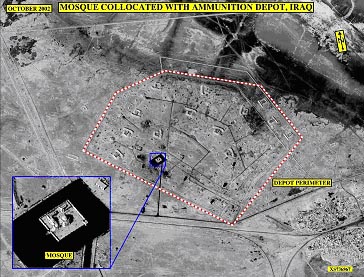
The Iraqi regime's propaganda campaign went far beyond normally-expected protests over civilian casualties. The Iraqis quickly realized that placing military assets – including tanks, missiles, and command-and-control facilities – close to civilians and civilian infrastructure could yield substantial benefits. By shielding military assets with civilians and civilian infrastructure, Saddam understood that coalition forces would either avoid attacking targets close to civilians or risk severe political damage from unintended civilian deaths at what would have appeared to be a purely military site.
The co-location strategy has three objectives:
Some of the regime's co-locations were clearly detectable through overhead imagery. Those that were not yielded tragic results – and a rich vein of propaganda. This is a long-standing practice: Throughout the country, the Iraqi government continues to locate military assets close to or together with civilian facilities and cultural sites, and it continues to build new mosques and other civilian facilities in or near military areas.
Iraqi Co-Locations of Military and Civilians. Then...
CNN reporter Peter Arnett wrote that one night during the Gulf War a SCUD missile and launcher appeared
on the front lawn of the Al-Rashid Hotel, where he and other journalists were staying.2
In 1990, the international press widely reported that Iraq had held more than 1,000 Western and Japanese men, women, and children as human shields at about 70 sites in Iraq, including air force bases, military garrisons, weapons factories, and power plants before eventually releasing them under international pressure.
During the Gulf War, the Iraqi regime placed two military aircraft next to the ancient Ur ziggurat near Tallil, Iraq. A coalition strike on the aircraft could well have caused extensive damage to this ancient Mesopotamian cultural treasure.
When coalition leaders publicly stated that religious sites would not be targeted, Saddam began using these sites to shield military equipment and units. In other cases, dual use facilities were exploited for propaganda value.

On January 21, 1991, coalition bombers hit what the Iraqis claimed was a "baby milk factory" in Baghdad. The United States insisted that Iraq was using it as a biological-weapons development site. It appears the facility had briefly functioned as a "baby milk" factory in 1979 and 1980, and then again in the spring and summer of 1990, before the Iraqi regime began to use it as a biological weapons site.
As U.S. officials pointed out at the time, the Iraqi regime was defending the site as it would a military facility. After the Gulf War, UNSCOM inspectors discovered that three scientists from the Iraqi regime's main biological weapons facility had been assigned to the "baby milk" factory.
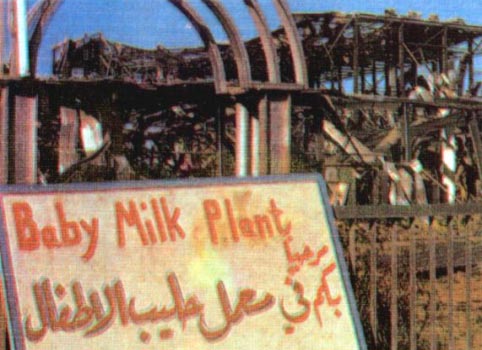 Journalists who were taken to the "baby milk" factory in 1991 saw this hand-lettered sign in English and Arabic.
Journalists who were taken to the "baby milk" factory in 1991 saw this hand-lettered sign in English and Arabic.
|
...And Now.
Since the Gulf War, the Iraqis regularly have placed Air Defense missile systems and associated equipment
in and around numerous civilian areas including parks, mosques, hospitals, hotels, crowded shopping districts,
ancient cultural and religious sites, and even cemeteries. They have placed rocket launchers next to soccer
stadiums that were in active use, parked operational SAM systems in civilian industrial centers.
In late 1997, the Iraqi regime made sure the world media filmed Iraqi civilians, including women and children, at military and industrial sites. The U.S. government later learned that it then secretly replaced the civilians with prisoners, who were mostly opposition figures but also included some criminals. If the sites had been attacked, the Iraqi regime was poised to claim that any prisoners killed were the Iraqi civilians who had previously been there.
In April 2002, commercial satellite imagery showed that the Iraqis had constructed 15 military revetments near a school in Saribadi, a town 31 miles southeast of Baghdad. Some of the revetments, essentially holes in which military vehicles are parked as protective measures against air strikes, are less than 11 yards from the wall surrounding the school.
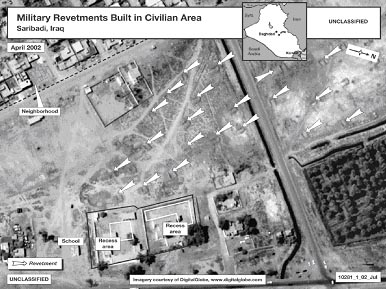 Military revetments (arrows) in civilian area of Saribadi, April 2002.
Military revetments (arrows) in civilian area of Saribadi, April 2002.
|
In 2002, the United States government learned that the Iraqi government had ordered taxis and buses to be repainted with military colors in order to look like military vehicles.
On January 8, 2003, the Associated Press and others reported that Iraqi Deputy Prime Minister Tareq Aziz welcomed foreign volunteers to come to Iraq and serve as human shields around civilian facilities in the event of armed conflict, thereby planting the idea that civilian facilities would be subject to attack. Iraq issued similar calls for volunteers in 1990. In the event of conflict, such human shields would most likely be deployed around military targets – either to deter strikes against the targets or to create casualties in the event of their being struck.
|
|||
 Visitors tour the Amiriyah Bunker. The Iraqi government has preserved the bunker as a publich memoral.
Visitors tour the Amiriyah Bunker. The Iraqi government has preserved the bunker as a publich memoral.
|
Exploiting Suffering
The Iraqi regime is skilled at seizing – and creating – opportunities to undermine the international community's resolve to maintain UN sanctions. And one of its most effective tools for accomplishing this goal is the systematic creation of hardship and suffering for the Iraqi people. While devoting massive resources to opulent palaces and huge weapons programs, the Iraqi government makes food and medicine scarce for average citizens. It then shifts the blame for the suffering of the Iraqi people from Saddam's policies to the United Nations, which established the sanctions. The real reasons for the suffering are quickly overwhelmed by the emotional weight of crying or emaciated children, doctors lamenting the lack of medicines and supplies, and parents pleading for relief.
Saddam Hussein's government uses tragic images to influence world opinion, and particularly to support the false allegation that the United Nations is killing Iraqis. These images include:
In a particularly shocking practice, the regime is known to collect the bodies of dead babies and store them for months at a time, so that they can stage mass funeral processions and create the impression that UN sanctions are killing small children.
The Iraqi regime has diverted to its weapons program or to luxuries for the regime's elites many millions of dollars that were intended for food, medicines, and other necessities. Under the UN sanctions exceptions, Iraq is explicitly allowed to import food and a wide range of medicines and other necessities, and the UN Security Council has expanded the list of allowable items several times in response to humanitarian and infrastructure needs. The regime either deliberately caused medical scarcity and malnutrition or simply saw that the suffering of the Iraqi people caused by its policies could be exploited for its propaganda value.
In either case, weapons for the armed forces and luxuries for ruling elites took priority over food and medicines for the people, and the regime found it more useful to continue the hardships and blame them on the sanctions than to meet its obligations and end the suffering. In 2000, Forbes magazine estimated Saddam Hussein's personal wealth at $7 billion, acquired primarily from oil and smuggling.
Blaming Sanctions for Regime Failure
In a total of 29 separate resolutions,6 the UN Security Council has stated clearly its reason for imposing
sanctions: to force Iraq to comply with previous UN resolutions. But Saddam Hussein refuses to comply. In
1990, under UN Security Council Resolution 661, the UN permitted food and medicine imports. Beginning in
1991, the Security Council attempted to create an Oil-for-Food Program that would allow Iraqi oil to be
sold, with proceeds deposited in an UN-controlled account and used to purchase food, medicine, and humanitarian
goods for the Iraqi people.7 The Iraqi government rejected this proposal.
In 1995, over Iraq's protests, the Security Council adopted another oil-for-food resolution.8 It was only in 1996, after another year and a half of Iraqi delays and international pressure, that the Iraqi regime finally agreed to accept oil-for-food, allowing the first imports to arrive in 1997. Even after the program was in place, the regime continued to deprive its citizens of the food and medical commodities that the international community wanted to supply. In 22 subsequent resolutions the Security Council extended, revised, adjusted, or expanded the Oil-for-Food Program out of concern for the people of Iraq, consistently broadening the range of goods permitted for importation.9
Iraq claims that 1.7 million children, including 700,000 under the age of five, out of a total national population of 22 million people, have died because of sanctions. According to an Iraqi government website, after the Oil-for-Food Program was instituted the number of children who died before the age of five jumped 50 percent from 1996 to 2001. The facts tell a different story:
|
|||
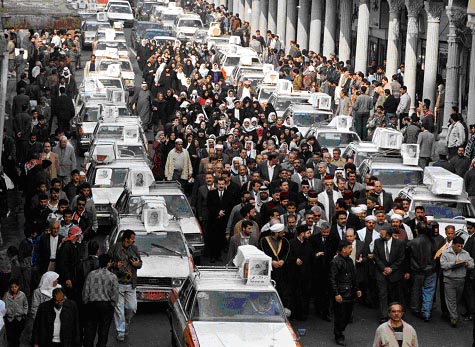 A government-organized baby-funeral procession in Baghdad, 1998.
A government-organized baby-funeral procession in Baghdad, 1998.[Faleh Kheiber/Reuters] |
Depleted Uranium Scare
During the Gulf War, coalition forces used armor-piercing ammunition made from depleted uranium, which is ideal
for the purpose because of its great density. In recent years, the Iraqi regime has made substantial efforts to
promote the false claim that the depleted uranium rounds fired by coalition forces have caused cancers and birth
defects in Iraq. Iraq has distributed horrifying pictures of children with birth defects and linked them to
depleted uranium. The campaign has two major propaganda assets:
But scientists working for the World Health Organization, the UN Environmental Program, and the European Union could find no health effects linked to exposure to depleted uranium.
The truth has not deterred the Iraqi disinformation campaign. On November 15, 2000, the London-based Arabic-language newspaper Al-Quds al-Arabi reported that Iraq had set up an organization called the "“Central Committee for the Follow-up of the Consequences of Pollution" under the direct supervision of Deputy Prime Minister Tariq Aziz, to pursue this issue. It also reported that Iraqi Major General Abd-al-Wahhab Muhammad al-Juburi headed a working team of military personnel, scientists, and others to generate data and organize tours for the international media. Iraq has hosted international conferences on the alleged ill effects of depleted uranium and sent "experts" abroad to speak on the subject, including Iraqi professor Mona Kammas, a member of Iraq’s "Committee of Pollution Impact by Aggressive Bombing."
Medical Facts on Iraqi Chemical Weapons Exposure
The Iraqi News Agency website directs viewers to a gruesome picture of a boy from the city of Mosul, with
the caption, "We say to human rights advocate: Look what their bombs have done to the children of Iraq.
Look how they use internationally banned weapons, including Depleted Uranium ammunition, in their
aggression against Iraq." In November 2000, the Iraqi magazine Alif Ba' claimed that an Iraqi child
had been born with "two heads and three arms" because the mother had been exposed to depleted uranium.
If there has been an upsurge in birth defects and cancers in parts of Iraq, it is most likely to have been caused by the regime's use of chemical weapons from 1983 to 1988, including mustard gas and nerve agents. Saddam Hussein used chemical weapons in southern and northern Iraq against the Iranians, with whom they were at war from 1980-88, and against the Iraqi Kurds, as in the well-known chemical attacks in the northern town of Halabja. Mustard gas has long been known to cause cancers and is strongly suspected of causing birth defects.
Dr. Christine Gosden, professor of medical genetics at the University of Liverpool researched congenital malformations, fertility and cancers in Halabja in 1998. Says Dr. Gosden: "What I found was far worse than anything I had suspected ... . Conditions such as infertility, congenital malformations and cancers (including skin, head, neck, respiratory system, gastrointestinal tract, breast and childhood cancers) in those who were in Halabja at the time ... are at least three to four times greater, even 10 years after the attack. An increasing number of children are dying each year of leukemias and lymphomas. The cancers tend to occur in much younger people in Halabja than elsewhere, and many people have aggressive tumors ...."19
Dr. Gosden also described a visit to a hospital in Halabja: "The staff in the labor ward told of the very large proportion of pregnancies in which there were major malformations. In addition to fetal losses and perinatal deaths, there is also a very large number of infant deaths. The frequencies of these in the Halabjan women is more than four times greater than that in the neighboring city of Suleymania... The findings of serious congenital malformations with genetic causes occurring in children born years after the chemical attack suggest that the effects from these chemical warfare agents are transmitted to succeeding generations."20
According to Dr. Fouad Baban, Chairman of the Department of Medicine of Suleymania University, "Congenital abnormality rates in [Halabja] are four to five times greater than in the post-atomic populations of Hiroshima and Nagasaki. Rates of stillbirths and miscarriages in the town are even more alarming. Rare and aggressive cancers in adults and children are found at levels far higher than anywhere in the world."21
Exploiting Islam
Saddam Hussein tries to harness feelings of solidarity among Muslims to his advantage. By portraying himself as a devout believer and invoking the name of Allah in his struggles with the international community, he seeks to frame his conflicts as an Islamic struggle and fashion himself as standard-bearer for Muslims. Images of Saddam in prayer or extolling Saddam’s dedication to Islam appear on billboards in Iraq and are circulated in pictures, publications, and videos.
One 1990 analysis concluded, "In recent years, the Baathists have not hesitated to exploit religion as a mobilizing agent; and from the first months of the war with Iran, prominent Baathists have made a public show of attending religious observances. Saddam Hussein is depicted in prayer on posters displayed across the country. Moreover, the Baath Party has provided large sums of money to refurbish important mosques."22 This is a departure from the secular origins of Saddam Hussein’s Baath Party. Baathists view Islam as a product of Arab culture and a bridge to pan-Arabism, and until 1990, Iraq was the only officially secular state in the region. Over time, the personality of Saddam Hussein has supplanted Baath Party doctrine, but one factor has not changed: The key figures in Iraq’s regime and ruling party remain non-religious or even non-believers.
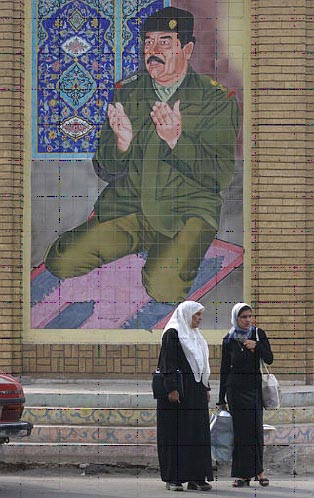 November 2002: Women in Baghdad wait for a cab in front of a mural of Saddam Hussein in prayer.
November 2002: Women in Baghdad wait for a cab in front of a mural of Saddam Hussein in prayer.[AP/Wide World] |
According to Daily Telegraph (London) editor Con Coughlin, author of King of Terror: A Biography of Saddam Hussein, in a November 8, 2002, interview with CNN American Morning:
"Saddam is an opportunist. He's not really a devout Muslim. But when it suits him, he portrays himself as a Muslim leader. And I think when your correspondents go to Baghdad, they see all these pictures of Saddam the nation builder, the general; Saddam the religious leader."
In reporting on the regime's lavish mosque-building program since the mid-1990s, while consumer goods and many necessities were in short supply or unavailable in Iraq, the Los Angeles Times quoted a European diplomat in Baghdad, who spoke on condition of anonymity:
"The people's well-being is not on the priority list of the regime. The regime is solely concerned with its own survival. A huge mosque-building scheme may help the formerly secular – almost atheist – and socialist regime to get more fully reincorporated into the family of the Arab nations, whereas the plight of a majority of the ordinary people can be used as its propaganda shield."23
The Hajj Shakedowns
Nowhere is the dichotomy between Saddam's religious rhetoric and practice more obvious than with the
way he has treated faithful Iraqis seeking to make the Hajj. The Iraqi regime interferes with religious
pilgrimages, both of Iraqi Muslims who wish to make the Hajj to Mecca and Medina and of Iraqi and non-Iraqi
Muslim pilgrims who travel to holy sites within the country. Baghdad has refused all proposals for travel
that did not involve direct payments to the government.
In 1998 the UN Sanctions Committee offered to disburse vouchers for travel and expenses to pilgrims making the Hajj, but the Government rejected this offer. Then again in 1999 the Sanctions Committee offered to disburse funds to cover Hajj-related expenses via a neutral third party; the Government again rejected the offer. Following the December 1999 passage of UN Security Council Resolution 1284, the Sanctions Committee proposed to issue $250 in cash and $1,750 in traveler’s checks to each individual pilgrim to be distributed at the UN office in Baghdad in the presence of both UN and Iraqi officials. The Government again declined and, consequently, no Iraqi pilgrims were able to take advantage of the available funds or of the permitted flights. The Government also has attempted to use pilgrimages to circumvent sanctions for its own financial benefit. In 2001 the Government continued to insist that UN-offered funds for Hajj pilgrims be deposited in the government-controlled central bank and placed under the control of government officials for disbursement rather than given to the pilgrims.24
The regime has imposed a variety of schemes to extract money from religious pilgrims by requiring them to pay fees directly to the Iraqi Central Bank. Estimates vary considerably, but it is clear that Saddam Hussein brings in millions of dollars annually in this way. According to the Coalition for International Justice:
"After refusing yet another UN plan to fund travel for the Hajj in 1999, Baghdad bused some 18,000 Iraqi pilgrims to the Saudi border, where they were encouraged to demonstrate and demand that the Saudis release frozen Iraqi funds to pay for their trip. Instead, King Fahd welcomed the Iraqi pilgrims and promised that Saudi Arabia would provide all arrangements free of charge. With no prospect of Saudi payments to the government from frozen funds or other sources, Saddam ordered the pilgrims back to Baghdad."
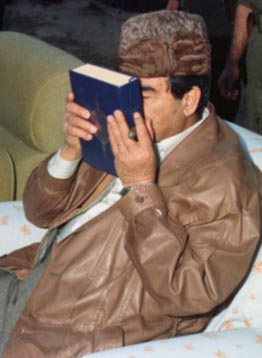 Images showing Saddam Hussein in acts of Muslim piety are widely disseminated in Iraq and other Muslim countries
Images showing Saddam Hussein in acts of Muslim piety are widely disseminated in Iraq and other Muslim countries[Reuters] |
The Gulf War: Lies About Non-Muslim Militaries in the Middle East
During the Persian Gulf War, Saddam exploited the fact that non-Muslim troops were fighting Muslim Iraq,
hoping to portray the war as a war against Islam. Iraq claimed that Islamic sites had been attacked, and
appealing to Muslim suspicion of Western morality and Western attitudes toward Islam, Iraq asserted that
coalition forces had desecrated holy sites and brought immorality to Saudi Arabia.
In assembling the international coalition, President George H.W. Bush cited the immorality and illegality of Iraq's invasion of Kuwait and called for the liberation of the Kuwaiti people. The United Nations Security Council passed resolutions authorizing the use of force to liberate Kuwait. Iraq sought to undermine the idea that Americans and other Western members of the coalition were liberators of Kuwait and to exploit anxiety over the presence of armed outsiders on Arab soil. To achieve these ends, the Iraqi regime invented reports of crimes by Western military against ordinary Muslims or important national symbols. Some reports alleged that people had been killed or wounded while engaging in some act of anti-coalition protest, in an attempt to create the additional impression that opposition to the war was growing in the Arab or Muslim world. Some claims:
The Gulf War: Lies About Conflicts between Muslim and Western Allies
The coalition for Operation Desert Storm was a broad alliance of Western and non-Western countries,
and the participation of many Muslim countries in the coalition deprived the Iraqi regime of the
opportunity to frame the conflict as one between Islam and non-believers. In an effort to ignite
opposition to the coalition in Arab and Muslim countries, the Iraqis invented tales of discord or
outright conflict between Western and Muslim military personnel, using mostly covert action and
state-run media. In these tales, Muslim-country militaries usually suffered some humiliation or
loss of life at the hands of their Western allies before managing to kill a few of the alleged
tormentors. None of these claims is true. Specific false claims included:
Corrupting the Public Record
Lies and false images placed in the public record are important elements of Iraqi disinformation. Iraqi officials have forged documents, staged scenes for international photographers and television, placed false stories covertly in newspapers and magazines, and lied on the record. During the Gulf War the Iraqis falsely asserted on the record that there had been victories by the Iraq armed forces, Israeli involvement in coalition military operations, and internal fighting in the coalition between Muslims and Westerners. Some examples were clearly intended for the Iraqi and Arab public, such as an official claim reported by Radio Monte Carlo on January 17, 1991: "There were massive pro-Saddam demonstrations in Cairo." Or an Iraqi News Agency claim on January 22, 1991: "25,000 Saudis, including key figures, have sought refuge in Yemen."
Self-inflicted Damage
During the Gulf War, on February 11, 1991, the Iraqis deliberately removed the dome of a mosque in
Al-Basrah and dismantled it, in an attempt to make it appear as if the damage had been caused by
coalition bombing. But there was no damage to the minaret, courtyard building, or the dome foundation,
which would have been the case if the building had been struck by coalition
munitions.26
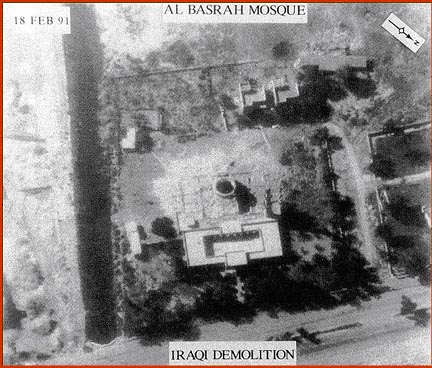
False Man-in-the-Street Interview
Journalists or visitors to Iraq are often witnesses to "spontaneous" outpourings of grief or anger by what
appear to be common people, or hear stories about hardships supposedly caused by the United Nations economic
sanctions. In one international news broadcast during Operation Desert Storm focusing on a missile that
had struck near a civilian area, a woman posing as a casual passer-by spoke to the camera in fluent English
about the "criminal bombing of Iraq." But American diplomats who had served in Iraq recognized her as
Suha Turayhi, a career minister in the Iraqi foreign ministry.27
Censorship
The easiest way to manipulate images is to control and censor outgoing broadcasts. During the Gulf War,
the Iraqis would not allow CNN and other media to broadcast scenes of damage to Iraqi military
installations–only footage of civilian casualties. According to the February 9, 1991, Washington Post:
"[BBC cameraman Peter Jouvenal] said censors had excised footage showing damage to military targets at a bridge
destroyed by allied bombers at Nassariyah, south of Baghdad, to make it appear that the only victims of the
raid were civilians. At a nearby hospital, he told the BBC he was prevented from filming soldiers wounded in
the raid. At one point, he said, an official escort covered with a blanket the uniform of one victim to make
him appear to be a civilian."
Covert Placement
The following scenario reflects another, especially egregious corruption of the public record: An Iraqi
government intelligence officer, diplomat, or operative provides a journalist or publication in another
country with a false story. The story contains specific details that appear to bolster the story's main
theme but cannot be verified. Sources or protagonists in the article are described in convincing detail but
without actually being named. Dates or places of supposed events are provided in order to give the article
texture and credibility.
The Iraqis have also built false stories around real events or meetings, so that falsehoods can be built around a skeleton of truth. The journalist may or may not know the original source of the material, and because these placements are made covertly, they cannot always be attributed with certainty to Iraq. But knowledge of Iraqi covert activities, clear evidence of Iraqi involvement in some covert placements, and strong circumstantial evidence combine to support attribution of the following items to Iraq. None of the reports cited below is true.
 This forged letter from Nigerian students in Saudi Arabia appeared in the October 28, 1990, issue of
the Nigerian newspaper Republic.
This forged letter from Nigerian students in Saudi Arabia appeared in the October 28, 1990, issue of
the Nigerian newspaper Republic.
|
|
|||
The Gulf War: False Claims of Victory
In the early days of Operation Desert Storm, the Iraqi regime issued a stream of false claims of military
successes. The target audience for this lie was non-elite Muslim publics, including Iraqis, and the Iraqis
used on-the-record statements, bogus stories, and sympathetic journalists to disseminate their story.
Examples of specific claims – all false – include:
Conclusion: The Lies Continue
This report shines light on the apparatus used by Saddam Hussein and his cadres to deceive the Iraqi people and the international community. The oppressive and totalitarian nature of Saddam Hussein's regime enables his deception and deceit. This regime, which became expert at obfuscation during the 1991 Persian Gulf War, has now had more than a decade to perfect these practices.
The Iraqi regime's intent to continue these lies is evident from recent actions. Should the United States and its allies determine that military action is necessary to disarm Saddam Hussein, the January 8, 2003, statement by Tareq Aziz illustrates what could await the international community. In this statement, the Iraqi Deputy Prime Minister and member of Saddam's inner circle invited friends of the dictator to serve as human shields. What Tareq Aziz does not tell them is that they will be defending Iraqi military equipment and a regime that tyrannizes its people.
All the while, the regime continues to profess poverty while generating significant amounts of money from the Oil-for-Food Program. During the period of January 4-10, 2003, Iraq exported 6.7 million barrels of oil, generating an estimated $174 million, according to the UN Oil-for-Food Program. The same program projects that for the period of December 2002 to June 2003, Iraq will generate $1.4 billion from its oil. The UN Security Council intended to allow the oil-for-food exchange to keep the Iraqi people from starving. As underscored in this report, while many Iraqi citizens face near starvation, Saddam Hussein continues to use oil wealth to build castles and weapons. All the while, the regime falsely blames the plight of the Iraqi people on UN sanctions.
This report puts into perspective other recent Iraqi actions, including their material breach of UN Security Council Resolution 1441. The resolution calls for a full, final, and complete disclosure of weapons of mass destruction and a verified disarmament process in Iraq. What the UN got was more lies and deception.
As Secretary of State Colin Powell said on Face the Nation on January 19, 2003: "It is [Iraq's] responsibility under 1441 to cooperate fully with the inspectors in the disarmament process. Dr. Blix says he has found no smoking gun, but he has also said that all he is getting from the Iraqis is passive cooperation. 'Catch us if you can. If you find something we might admit it. But we're working hard to deceive you, to hide things and make it harder for you to get to the truth.'"
Bibliography
Arnett, Peter, Live From the Battlefield, New York, Simon and Schuster, 1994.
Coughlin, Con, Saddam: King of Terror, New York, Ecco Press, 2002.
European Commission, Directorate General of Environment, Opinion of the Group of Experts Established According to Article 31 of the Euratom Treaty: Depleted Uranium, March 2001.
European Parliament, Directorate General for Research, Depleted Uranium: Environmental and Health Effects in the Gulf War, Bosnia, and Kosovo, April 2001.
Fialka, John, "Weighing Claims About Depleted Uranium," The Wall Street Journal, January 2, 2003.
Gosden, Christine and Mike Amitay, "Lessons of Iraq’s Mass Murder," by The Washington Post, June 2, 2002.
Gosden, Christine, "Why I Went; What I Saw," The Washington Post, March 11, 1998.
Hamza, Khidhir, Saddam's Bombmaker, New York, Scribner, 2000.
"Iraqi Weapons of Mass Destruction Program and the History of UN Inspection Efforts in Iraq," Witnesses: David Kay and Richard Spertzel, Hearing of the House Armed Services Committee, September 10, 2002.
Kamen, Al, "Iraqi Factories' Product: Germ Warfare or Milk?" The Washington Post, February 8, 1991.
Leventhal, Todd, Iraqi Propaganda and Disinformation During the Persian Gulf War: Lessons for the Future, Emirates Center for Strategic Studies and Research, 1999.
Loiko, Sergei L., "In Iraq, All Sanctions, All the Time," Los Angeles Times, January 6, 2003.
Metz, Helen Chapin, Iraq: A Country Study, U.S. Department of Defense, 1990.
"The Mother of all Ironies," BBC Correspondent, British Broadcasting Corporation, June 23, 2002.
Sweeney, John, "The Truth about Iraq's Dying Babies," London, The Observer Review, March 1, 1998.
Endnotes
1"Iraqi Weapons of Mass Destruction Program and the History of UN Inspection Efforts in Iraq," Witnesses: David Kay and Richard Spertzel, Hearing of the House Armed Services Committee, September 10, 2002, p. 30. http://www.fednet.net/archive/. See also "Scientists are Sought as Key to Iraqi Arms," by Joby Warrick, The Washington Post, December 15, 2002.